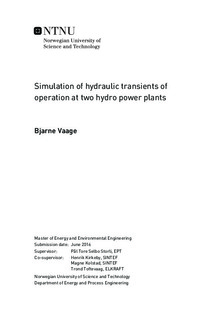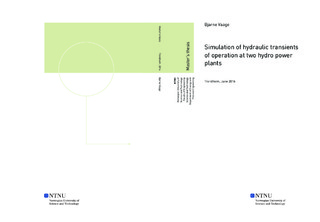Simulation of hydraulic transients of operation at two hydro power plants
| dc.contributor.advisor | Storli, Pål Tore Selbo | |
| dc.contributor.advisor | Kirkeby, Henrik | |
| dc.contributor.advisor | Kolstad, Magne | |
| dc.contributor.advisor | Toftevaag, Trond | |
| dc.contributor.author | Vaage, Bjarne | |
| dc.date.accessioned | 2016-08-26T14:01:35Z | |
| dc.date.available | 2016-08-26T14:01:35Z | |
| dc.date.created | 2016-06-09 | |
| dc.date.issued | 2016 | |
| dc.identifier | ntnudaim:14793 | |
| dc.identifier.uri | http://hdl.handle.net/11250/2402305 | |
| dc.description.abstract | The energy production in Europe is heading towards a green shift. The energy produced be renewable sources such as solar and wind are increasing day by day. This does however lead to a few issues. The energy produced by wind and solar power does not contribute in stabilizing the grid frequency as well as energy produced by fossil fuels. If this is not compensated for the grid frequency might experience larger variations than today, which is not desirable. From a hydro power perspective this fluctuating frequency will travel from the grid through the generator and turbine and it may cause pressure pulses in the conduit system in the power plant. In this thesis Bogna power plant will be investigated to check if and to what degree variations in the grid frequency will influence the power plant. As a part of the green shift there has been a large development of small hydro power plants in Norway. With the introduction of new grid codes that are supposed to unite the Norwegian standards to the rest of Europe the has been asked question of how well the small hydro power plants are able to handle small voltage deviations. In cooperation with SINTEF Bruvollelva power plant has been tested for such deviations. Both power plant has been modeled and simulation. The method used are the Method of Characteristics described by Wylie & Streeter. The method is implemented in the graphical programming package Simulink which is based on MATLAB. All the typical elements in a hydro power plant are implemented from the upper and lower reservoirs via the conduits, creek intakes and surge arrangements to the generator and runner. The turbine and generator are governed with classical PI-governors. In addition to this simple pressure measurements are preformed on Bruvollelva. The last field measurement on Bruvollelva yielded quite unexpected results. The pressure measurements showed something that reassembles a full water hammer course. This was attempted replicated in the simulations without success. The simulated values presented a much smaller pressure increase. The simulations of Bogna showed that the power plant will not be influenced to a large extent by a strongly varying frequency. The implemented models worked satisfactory for most simulation. There are however still room for a couple of improvements. The implementation of the turbine does not handle the closed state and tend to crash when the guide vane opening gets very small. The author does also question if the model of the generator is satisfactory accurate to model FRT-problems properly. In addition to this the two governors should be implement differently since they do not seem to work properly. More data from measurements should also be collected before arriving at a conclusion. | |
| dc.language | eng | |
| dc.publisher | NTNU | |
| dc.subject | Energi og miljø, Strømningsteknikk | |
| dc.title | Simulation of hydraulic transients of operation at two hydro power plants | |
| dc.type | Master thesis | |
| dc.source.pagenumber | 97 |

